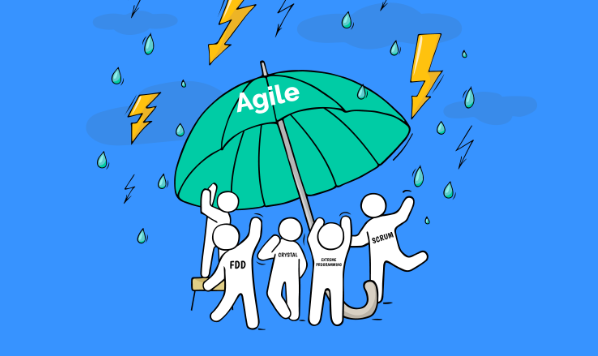As the business environment becomes more complex and volatile, organizations across the globe are adopting Agile and Scrum methodologies to stay competitive and relevant. However, the journey to successful Scrum adoption is often paved with obstacles and challenges. One question that often surfaces is, “Whose responsibility is it to lead and coach the organization in its Scrum adoption?” Let’s delve into this intriguing query and unravel the responsibility matrix that underpins successful Scrum adoption.
The Agile Leadership Umbrella

First and foremost, it’s important to underscore that the journey towards Scrum adoption requires strong Agile leadership. Agile leadership is all about fostering an environment where Scrum teams can thrive, nurturing a culture of collaboration, openness, and responsiveness to change.
The C-suite, especially, has a pivotal role in fostering an Agile mindset. They are the ones who set the direction, articulate the vision, and create an environment conducive to Agile ways of working. In essence, they are the catalysts for Scrum adoption, facilitating the organizational transformation through strategic vision and influence.
The Scrum Master: The Torchbearer of Scrum Adoption

When we delve deeper into Scrum adoption, one role that takes center stage is the Scrum Master. With their deep understanding of Scrum principles and values, Scrum Masters act as the torchbearers of Scrum adoption. They guide, coach, and support the Scrum Team, helping them to understand and implement Scrum practices effectively.
Scrum Master responsibilities are far-reaching, covering aspects like facilitating Scrum ceremonies, removing impediments, and promoting self-organization within the team. However, one of their most crucial responsibilities is coaching not only the Scrum Team but also the broader organization about Scrum, thereby paving the way for a successful Scrum adoption.
Product Owner: Championing the Scrum Values

Next, we have the Product Owner, another pivotal role in the Scrum framework. While the Product Owner is primarily responsible for maximizing the product’s value, they also champion the Scrum values and principles within their sphere of influence. They provide clear communication between the stakeholders and the development team, ensuring that everyone is aligned towards a common goal. The product owner, in essence, is a vital cog in the Scrum adoption wheel.
The Role of the Team in Scrum Adoption
It’s also essential to highlight the role of the team in Scrum adoption. The success of Scrum is heavily dependent on the collaboration, self-organization, and cross-functionality of the Scrum Team. Each team member has a part to play in the adoption process, from understanding and embracing Scrum values, to actively participating in Scrum events, to continually improving through retrospectives.
Embracing the Challenges of Scrum Adoption
Adopting Scrum is not without its challenges. Resistance to change, misunderstanding of Scrum roles and principles, and lack of executive buy-in are some of the common pitfalls to avoid. Addressing these issues head-on is a shared responsibility. Everyone, from the C-suite to the Scrum Team, has a part to play in tackling these hurdles and leading the organization towards successful Scrum adoption.
Enabling Scrum Adoption Through Agile Coaching
Coaching plays a critical role in Scrum adoption. An Agile coach is an expert who helps teams and individuals understand and apply Agile and Scrum principles effectively. They facilitate learning, address roadblocks, and foster an Agile mindset. Agile coaches are instrumental in catalyzing organizational change and ensuring a smooth transition to the Scrum framework.
Cultivating Success in Scrum Adoption
In conclusion, the responsibility of leading and coaching the organization in its Scrum adoption is not confined to a single role. It’s a shared responsibility that encompasses Agile leadership, the Scrum Master, the Product Owner, the Scrum Team, and even Agile coaches. Together, they form a powerful coalition that can navigate the organization through the complexities of Scrum adoption, ensuring a successful transition towards a more Agile, responsive, and effective way of working.
Scrum Implementation Challenges
Despite the many benefits of the Scrum framework, the journey towards adoption is often riddled with roadblocks. Some common challenges that organizations face during this process include entrenched organizational culture, resistance to change, lack of understanding about Scrum, and inadequate commitment from top management. It’s important to remember that overcoming these challenges is a collective responsibility – all members of the organization must be prepared to confront these issues together.
The Agile leadership can play a crucial role in mitigating these challenges by setting clear expectations, communicating the benefits of Scrum, promoting transparency and openness, and facilitating continuous learning and adaptation. They can also champion Scrum adoption by modeling Agile behaviors and fostering an environment where experimentation and feedback are valued.
Strategies for Successful Scrum Adoption
Scrum adoption is a journey, and like any journey, it needs a roadmap. This roadmap should include specific strategies for overcoming resistance, fostering an Agile mindset, and ensuring continuous improvement. Here are a few key strategies that can facilitate successful Scrum adoption:
1. Gradual Implementation: Rather than adopting Scrum in one fell swoop, it often works better to implement it gradually. Start with one or two teams, learn from their experiences, and then scale up based on the insights gained.
2. Training and Education: Comprehensive training and education about Scrum principles, values, roles, and practices are critical. This not only equips the teams with the necessary knowledge but also helps in dispelling myths and misconceptions about Scrum.
3. Continuous Improvement: Embrace the idea of continuous improvement. Encourage regular retrospectives and use the insights gained to fine-tune processes and practices.
4. Engaging an Agile Coach: An Agile coach can bring a fresh perspective, provide expert guidance, and help in addressing specific challenges that the teams might face during the Scrum adoption journey.
Benefits of Scrum Leadership
Effective Scrum leadership can make a world of difference in the adoption process. A dedicated Scrum leader, whether it’s a Scrum Master or an Agile Coach, can guide the team and the organization through the complexities of Scrum adoption. They can serve as a bridge between the team and the stakeholders, facilitate effective communication, remove impediments, and promote a culture of continuous learning and improvement.
Fostering an Agile Mindset
An Agile mindset is a critical success factor for Scrum adoption. It’s about embracing change, promoting collaboration, prioritizing customer satisfaction, and striving for continuous improvement. Cultivating this mindset is not a one-off task but a continuous journey.
The leadership can foster an Agile mindset by promoting the Agile values and principles, modeling Agile behaviors, and creating an environment that encourages learning, experimentation, and adaptation. By doing so, they can ensure that the organization is not just doing Scrum, but also being Scrum – which is the essence of successful Scrum adoption.
FAQs About Whose Responsibility is it to Lead and Coach the Organization in its Scrum Adoption?
Q: What are the key responsibilities of a Scrum coach?
A: A Scrum coach or an Agile coach is responsible for helping teams and individuals understand and apply Agile and Scrum principles. They facilitate learning, address obstacles, and foster an Agile mindset.
Q: How can an organization effectively implement Scrum?
A: Effective Scrum implementation requires strong Agile leadership, a deep understanding of Scrum principles and values, a commitment to continuous learning and improvement, and the ability to embrace change.
Q: What are the challenges in leading a Scrum adoption within an organization?
A: Some common challenges include resistance to change, misunderstanding of Scrum principles and roles, lack of executive buy-in, and difficulties in adapting to a new way of working.
Q: What is the role of a Scrum Master in coaching the organization?
A: The Scrum Master is the torchbearer of Scrum adoption, guiding, coaching, and supporting the Scrum Team and the wider organization in understanding and implementing Scrum practices.
Q: How can leaders support and encourage Scrum adoption in their organization?
A: Leaders can support Scrum adoption by fostering an Agile mindset, setting the strategic direction, providing resources and support, and promoting a culture of collaboration, openness, and responsiveness to change.
Q: What strategies can be used to overcome resistance to Scrum adoption within an organization?
A: Key strategies include gradual implementation, comprehensive training and education, fostering an Agile mindset, and engaging an Agile coach. Encouraging open communication, promoting transparency, and valuing feedback can also help in overcoming resistance.
Q: What are some successful examples of organizations that have embraced Scrum?
A: Many leading organizations, including Google, Microsoft, Spotify, and IBM, have successfully embraced Scrum and are reaping the benefits of improved productivity, enhanced product quality, increased customer satisfaction, and more efficient project management.
Q: How can an organization foster an agile mindset during Scrum adoption?
A: An organization can foster an Agile mindset by promoting Agile values and principles, modeling Agile behaviors, and creating an environment that encourages learning, experimentation, and adaptation. Regular training, coaching, and retrospectives can also help in cultivating an Agile mindset.
Also Read: Kutty Movie Download (Tamil Movie 2023
In sum, the responsibility to lead and coach the organization in its Scrum adoption is shared across various roles. Agile leadership, Scrum Masters, Product Owners, Scrum Teams, and Agile Coaches all have a significant role to play in this journey. Together, they can drive successful Scrum adoption, transforming the organization into a dynamic, flexible, and responsive entity that is well-equipped to navigate the complexities of today’s volatile business environment.
To sum it up, this article has shed light on various aspects of “Whose Responsibility is it to Lead and Coach the Organization in its Scrum Adoption?” providing valuable insights and answering your most pressing questions.

Aretha Davis, the wordsmith extraordinaire, weaves enchanting tales with her pen and keyboard. A renowned blogger and writer, her captivating prose transports readers to realms unknown. Join her literary journey and be swept away by the magic of her words.
